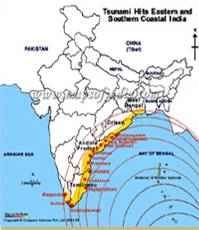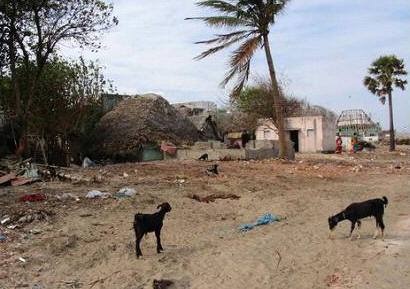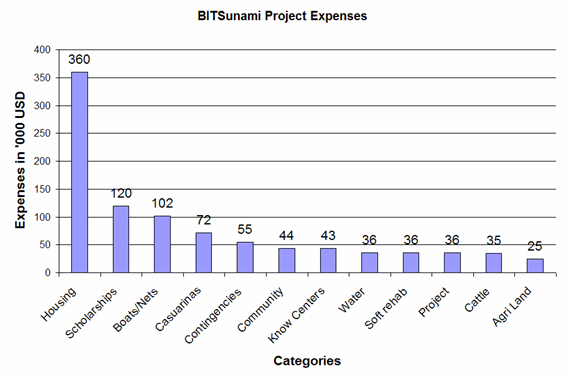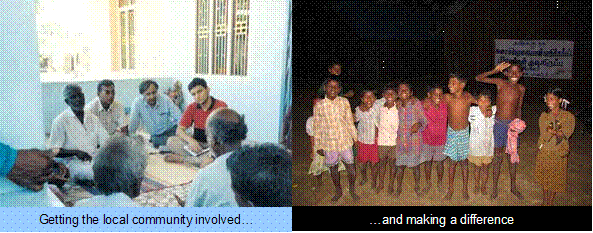 As
you’re all probably
already aware, in December this past year Tsunamis
of biblical proportions struck India and
several other countries. Sadly
enough, this was merely the latest in a spate of
natural disasters – adding to the adversity
inflicted by the super cyclone that hit Orissa in
1999 and the earthquakes that rocked Gujarat in
2001.
As
you’re all probably
already aware, in December this past year Tsunamis
of biblical proportions struck India and
several other countries. Sadly
enough, this was merely the latest in a spate of
natural disasters – adding to the adversity
inflicted by the super cyclone that hit Orissa in
1999 and the earthquakes that rocked Gujarat in
2001.
Cities, coastal communities and seaside resorts were
devastated. Over 290,000 people lost their lives and
thousands others were injured. Several countries
including Indonesia, Sri Lanka, India and Thailand
were affected as over a million people were rendered
homeless. The World Bank reports that the Tsunami
will cost India alone an estimated $1.2B in
reconstruction. And yet again, as we have seen so
often in the past, it is in the face of shared
adversity that people cast aside their immediate
worries and differences and unite with a common goal
of making a difference in the lives of those
affected. As Shankar (BITSunami team, Sub-Editor –
The Hindu), describes it “such cataclysmic events
serve not merely as opportunities for resurrection
but also as checkpoints to re-examine our own lives,
regain a sense of perspective and give back to our
communities.”
In
a most touching display of humanity, people all over
the world, BITSians included, sent in donations to
effect immediate relief, volunteered their
assistance and did all that was humanly possible to
help.
But it isn’t mere
charity that’s the answer in such situations as
Laxman, a member of the Sandpaper team discovered
when he visited cyclone affected villages in Orissa.
The villagers who used to be relatively affluent
explained that they found it hard to accept external
‘aid’ and instead of rice or items of daily need
were more interested in ways to rebuild their local
economies and regain their financial
self-sufficiency as quickly as possible.
 Rehab
or relief?
Rehab
or relief?
While many rushed in with relief by way of money and
materials, contributions which were certainly
appreciated and commendable no doubt, some within
the BITSAA community recognized that in the midst of
this disaster, there was the need for, and an
opportunity to launch an initiative dealing in
longer-term results and sustainable development. Or
as our Vice-Chancellor described it, a ‘holistic’
effort. This notion led to the formation of the
BITSunami team.
Close to
Ground Zero, a team from BITSAA’s Chennai chapter,
with members ranging from 25 to 75 years in age, got
(and still are) busy putting together a rehab
initiative, valued at over a million dollars, and
BITSAA chapters across the globe are embracing the
project wholeheartedly and with immense pride.
The
distinction and rationale for billing the effort as
rehabilitation-focused is because it involves
integrated development and is comprehensive in
nature, embracing all of the following elements:
Infrastructure rebuilding:
Houses, community buildings, roads, over bridges
Livelihood growth:
Fishing, boats, nets, new techniques.
Agriculture:
Land fertility reclamation, cropping pattern, cattle
and poultry
Health &
Sanitation:
Health center, water purification system, noon-meal
scheme for children, medical camps
Education:
School renovation, creating endowments etc
Trauma
Care:
Psychological counseling and rehab to lead a normal
life
Ecology
rehab:
Coastal defense mechanisms
 The Vision
The Vision
Rehabilitate two villages in the hardest hit areas.
Nagapattinam, the Tamil Nadu district in
which the two villages, Naaluvedapathy and
Pushpavanam are located, was one of the worst
affected areas
Value proposition
-
The
BITSunami effort is distinctive in its approach
in the following five ways:
-
The comprehensive nature of the rehabilitation –
Integrated Development
-
The incorporation of the knowledge and the
involvement of the local populace in executing
the project to deliver meaningful results.
-
The formal involvement of BITS Pilani led by the
Vice Chancellor himself. The enthusiastic
response from BITSians around the world, a host
of corporations of international repute such as
Wipro, WeP, HP, Polaris, Infineon and the
involvement of a number of non-government
organizations.
-
A group of highly committed and qualified
professionals who can bring in innovative
solutions – read BITSians. This is by virtue of
having one of the largest, most collaborative
alumni professionals.
-
Overheads kept to a bare minimum with everybody
chipping in. Want figures? Just Rs.3K a month
for a coordinator at the village level, Rs.10K a
month for the overall coordinator based in
Chennai. Another coordinator at Nagappattinam
district in a month or two would cost just Rs.6K
per month.
Appeal to BITSians
The communities need BITS Pilani alumni to prove that we are equal
to the task of completely changing the face of two
villages impacted by a tragedy after the NDTV and
CNN crews have left.
Just
giving up a minor luxury could mean providing a
basic necessity to a villager, as Sudeep Jain, IAS,
(BITSunami team member) points out “the equivalent
of two cold drinks per day for the duration of the
project would be immensely valuable”.
Whether
you are involved in sending funds, assisting with
funding efforts, spreading the word through your
network of friends or organizing events, every
little bit counts.
Project Details
The Nagapattinam district was one of the
worst affected districts in mainland India during
the Tsunami disaster. Close to 100,000 have been
rendered homeless and more than 6,000 lives have
been lost. The devastated villages will require
extensive involvement by government, philanthropists
and people like you and me to restore a semblance of
normalcy.
Stirred by the calamity, like-minded professionals
from Pilani expressed a desire to leverage their
technical and networking skills to reach out to and
develop these villages. The entire project is being
routed through BITS Pilani Alumni Tsunami
Rehabilitation Trust (BITSUNAMI in short) – a trust
formed by the alumni in the Chennai chapter. The
District Collector of Nagapattinam and the
District Monitoring Commissioner are also assisting
with the team’s efforts.
Partnerships with focused NGOs such as LAFTI,
PREPARE, the Indian Council of Child Welfare (ICCW),
LEAD, BOBP (Bay of Bengal Project) and MS
Swaminathan Research Foundation (MSSRF) are also
being established.
The team project
will not just create these two model villages but
also inspire people around the globe and most
importantly, leave a lasting impression in the
lives of the villagers for generations to come. The Project will last
for five years with a project office at
Nagapattinam.
An interesting fact
about
Naaluvedapathy
is that through the efforts of Sudeep Jain, the
village is in the Guinness Book of World Records for
the achievement of planting 80,244 trees in 24 hours
using a 300-strong volunteer team. How the
plantation helped during the Tsunami is reported by
Reuters in the excerpt below.
Trees to combat tsunamis
An extract from a
Reuters Report,
January 30th 2005
Two years ago, drought-stricken farmers in a village
in Tamil Nadu walked into the Guinness Book of World
Records by planting the highest number of saplings
in a 24-hour period. On December 26, as the killer
tsunami struck down thousands of people and homes,
the casuarinas and eucalyptus trees, which had been
planted to appease the weather gods, saved the lush
green village of
Naaluvedapathy.
Of the nearly 8,000 people who died in the state,
including 6,000 in one fishing village, only seven
were from Naaluvedapathy.
The casuarina trees, which numbered more than
60,000, took the brunt of the tsunami waves as they
swept through the area. Sudeep Jain, who led the
plantation drive, has started a trust since the
tsunami struck to undertake tree plantation along
the 1,000-km coast of Tamil Nadu with the help of
his engineering school classmates (read BITSians).
“We don't need to anymore advertise the benefits of
tree plantation... (It) is the cheapest and best way
of rehabilitating the tsunami ravaged coastline,” he
said.
Funding
The
corpus of funds the project will need is almost a
million dollars, half of which we hope to raise from
BITSAA members worldwide and the other half from
philanthropists and companies through the efforts of
the team and BITSians. We appeal to you to
contribute generously to this fund.
Details
of the project elements and preliminary budget can
be read, not as simple mathematics, but as an
indication of how much has been lost and how much
can be retrieved through a small gesture on the part
of everyone.

Also, anybody who wishes to contribute to a holistic effort at
rehabilitation and integrated development of the
Tsunami affected area on a long term basis could do
so by committing funds in the immediate term and/or
also spread their contribution out over the next
five years. The team is also expecting corporate
sponsorship of project elements in entirety – these
are yet to be formalized and committed. Income Tax
exemption under Section 80G for contributions from
within
India has
been applied for.
Worldwide efforts
As news of the Tsunami rolled in, the immediate need was to
disseminate information to
BITSians worldwide on how they could get involved
including comprehensive advice from and specific
pointers on relief efforts, agencies, contributions
and potential matching donations. Several emails
whizzed across multiple BITSAA mailing lists as a
consequence of which our alumni community’s
awareness grew dramatically.
A fundraiser,
Nrithyanjali was organized in New Jersey with active
support from Pushkala (’95 MMS).
A number of people
volunteered and were involved with various
non-profit organizations on the ground. Srinivasa
Rao (’78 MMS), a resident of Singapore for close
to two decades now, was featured on Singapore’s
Channel News Asia for his exemplary work in this
realm. Other BITSians who were actively involved
during the Tsunami relief efforts include
Chandra (’91) and Smitha Kalyani (’96 Comp
Sc), active with the Association for India’s
Development (AID) in Chennai. Preetish Nijhawan
(’85) is on the Board of the Non Profit
Pratham and works in Austin, Texas. He went to
India subsequent to the Tsunami to contribute not
just monetarily but also to volunteer his services.
Ravi Baid (’86)
and his non-profit in Delhi, Roundtable India (RTI),
were involved in an extensive effort in Tamil Nadu
and a few other southern states. RTI was officially
approved as an NGO undertaking rehabilitation work
and rebuilding infrastructure.
Sridhar Nagarajan
(’94 Phy Chemical),
an AID volunteer in San Jose, worked in Chennai and
Koovathur in Kancheepuram district for 2 weeks (Jan
9, 2005 to Jan 23, 2005). At the end of his tireless
stint – including logistics, material management and
rehabilitation – he authored a first-hand
perspective on how humanity has come together to the
aid of
Tsunami victims.
“In summary, the
whole world has really come together in support of
this initiative. Life in Tamil Nadu in my view is
slowly but surely returning to normalcy. The relief
workers and the government are doing a great job.
Many friends I know have said ‘at the end of all
this, most people are going to feel good' about
this. Well, if not that, people need to realize that
natural disasters such as this cannot be controlled
but at least it is heartening to see that the world
is unified in dealing with the aftermath.”
We also thank and
acknowledge all of you who have contributed in so
many ways that we perhaps are not aware of and
please do stay involved...

Conclusion
The BITSAA Chennai
chapter has taken on this arduous but truly
inspiring task upon itself. This gives BITSians as a
community
a phenomenal opportunity to help and make a
difference. Holistic development on this scale
involves a firm commitment and one hopes that
BITSians and people the world over will continue to
extend their support to this noble venture. The
exercise will also create a knowledge base that can
be used in other villages or in similar situations,
god forbid, if it’s needed.
Let’s all commit to helping in any way we can.


